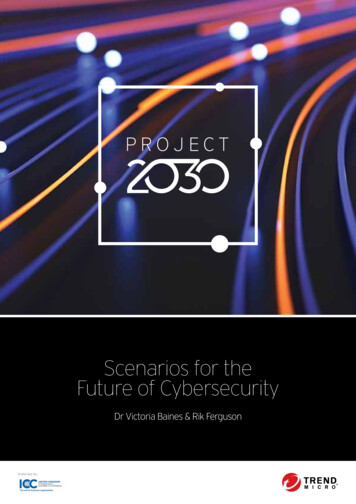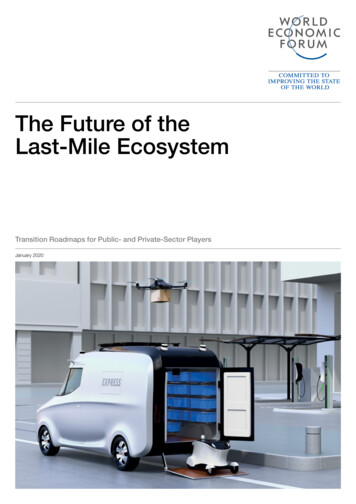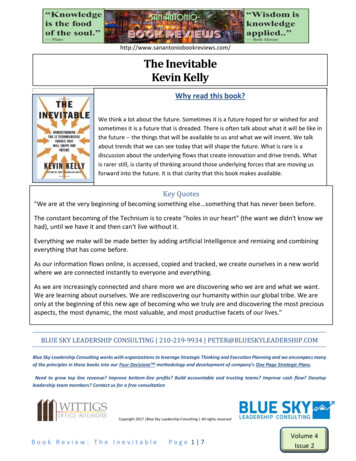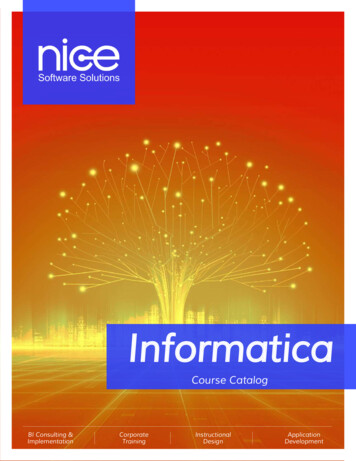
Transcription
Scenarios for theFuture of CybersecurityDr Victoria Baines & Rik FergusonEndorsed by:
Every year we all see many reports aggregating the results of surveys – and quite a fewthat seek to extrapolate the results into the future – but rarely do we see a report thatis as thought-provoking and insightful as “Project 2030 – Scenarios for the Future ofCybersecurity.”The report’s authors, Victoria and Rik, create a picture of what life for real people could looklike only nine short years from now, and look at the cybersecurity picture through the lensof the impact of technology from the perspectives of people, business and countries.Many reports on cybersecurity are, to paraphrase Winston Churchill, a sum of all our fears,or a dry recitation of facts and figures. Project 2030 is anything but.Of course, the future that Project 2030 posits will not be realised exactly as we see it here– but we can see in its pages elements which are almost certain to be realised: from theimpact of ‘deepfakes’ on increasingly connected people, to dramatic changes in productiondue to automation, and supply chain security issues.What is of overriding clarity is that cybersecurity issues will become more and moreimportant not just as policy objects, but to the general public, the more we are connectedto one another through technology. We all know this at some level, but what this reportdoes very persuasively, is show us why the cybersecurity problems of today, and how weapproach them, are integral to the health and well-being of us all tomorrow.The opportunities that technology has to offer us today are only a small portion of whatwe will see in a few short years. This report should provoke a great deal of thinking – andit should also provoke action. ICC United Kingdom is increasingly active in internationalcybersecurity policy precisely because it is the key to a shared future of opportunity thatminimises risks and promotes healthy outcomes.ICC United Kingdom are proud to endorse and recommend “Project 2030 – Scenarios forthe Future of Cybersecurity.”Chris Southworth,Secretary-General, ICC United KingdomProject 2030 – Scenarios for the Future of Cybersecurity Trend Micro2 of 37
Contents0423Security challenges and thenature of threatsImplications for CybersecurityStakeholders0528The View from 2020Beyond 20300729Scenario Narratives for 2030Appendices0729a. Citizen – ResilaScenario Method1130b. Business – KoRLo IndustriesTimeline Validation1531c. Government – New San JobanSurvey Questions1933Cyber ThreatsSurvey ResponsesProject 2030 – Scenarios for the Future of Cybersecurity Trend Micro3 of 37
About Project 2030“Human beings are really bad when it comes toinnovation. We persistently overrate the short termimpact of technology change, and underrate thelong term impact of technology change.”Live poll participant, December 2020Project 2030 is a Trend Micro research initiative. Its aim is toanticipate the future of cybercrime, and to enable governments,businesses and citizens to prepare themselves for the challengesand opportunities of the coming decade.The scenarios that we outline are not intended to represent theentirety of progress over the next decade. They are descriptionsof possible medium-term technological developments, with afocus on the impact of cyber threats from the perspectives of anindividual, a manufacturer and the apparatus of state. The eventsand developments described are designed to be plausible in someparts of the world, as opposed to inevitable in all. They are informedand inspired by analysis of the current threat landscape, the expertopinion of specialists in fields including information security, dataprotection, law enforcement and international relations, andextensive horizon scanning of emerging technologies.The authors would like to thank Sara Hook of Pulse Conferences forassistance in conducting the live poll of technology timelines, NeilWalsh for assistance in soliciting survey responses, and DamienBatchelor for specialist advice on the future of nanomedicine.Project 2030 – Scenarios for the Future of Cybersecurity Trend Micro4 of 37
The View from 2020Synthesis of threat reporting from international organisations and leading cybersecurity providersfacilitated the identification of a baseline of cybercriminal threats in 2020. Threats, enablers, and otherfeatures of the cybersecurity ecosystem identified by international organisations were as follows:Threats & VectorsAdversarial AIDDoSMalicious USB mailingBotnetsDoxxing/ information leakagePhysical manipulation/damage/lossBusiness email compromiseHigh profile data lossRansomware (targeted, high value,third party attacks)Business process compromiseInfluence operations/disinformationRemote access trojans (RAT)Credential stuffingInsider threatSIM swappingCrime as a serviceIoT compromise or DoS/ Edge attacksSMiShingCryptojackingLogical ATM/PoS attacksPhishing (themed/spear-/whaling)SQL injectionCyberespionageMalicious appsData stealing trojans (Emotet)Malicious domainsWeb exploitsSupply chain & third party compromiseEnablers & TargetsCloud/virtualisationMobileMisuse of legitimate businessstructures/toolsCriminal infrastructure(bullet-proof hosting)New ways for criminals to hideSocial MediaCriminal opportunismPrivacy-enhancing walletsDeepfakesDarkweb evolution/ regenerationSocial EngineeringOnline financial servicesUnpatched/discontinued/legacy applicationsEcosystemAutomated detectionCriminal opportunismNew threat actorsFig.1 Common features of 2020 cyber threat reporting from select international organisations11Based on manual review of Europol’s Internet Organised Crime Threat Assessment 2020, ENISA’s Threat Landscape 2020 (Year in Review,Threat Intelligence, and Emerging Trends reports), and Interpol’s COVID-19 Cybercrime Analysis Report.Project 2030 – Scenarios for the Future of Cybersecurity Trend Micro5 of 37
Common features of cybersecurity industry threat predictions in 2020 were grouped as follows:Threats & VectorsAPI attacksAdvanced Persistent Threat (APT)IoT-related attacksRansomware/double extortionEnablers & Targets5G & TelecomsCloud & EdgeCOVID-19 exploitationAutomation & Artificial IntelligenceConsequemces of teleworking/schoolingDeepfakesLegacy vulnerabilitiesEcosystemsCybercrime gang cooperationSecurity automationRegulatory & enforcement activityShorter patch windowsUser privacyFig.2 Common features of 2020 threat predictions from select cybersecurity providers2The aim of the rapid review was to ensure a threat baseline for the scenarios that was as complete aspossible. Therefore, no attempt was made to compare the findings of the international organisationswith those of the cybersecurity industry, or to reduce the respective features to comparable categories.Rather, all identified threats and vectors, enablers and targets, and features of the current cyber threatecosystem were taken into consideration when building the scenarios. As a result, there is considerableoverlap between items listed in Fig.1 and those in Fig.2. For example, nation state or state-sponsoredAdvanced Persistent Threat (APT) as outlined by industry in Fig.2 maps to cyberespionage as describedby international organisations in Fig.1: indeed, it is the same threat conveyed in different terminology.The COVID-19 pandemic inevitably looms large in cyber threat reporting for 2020. Exploitation of thepandemic, manifest in themed phishing, SMiShing and cyber-enabled frauds, but also in the nationstate arena with reported attempts to compromise vaccine research, speaks to a long-standing bent ofcybercriminal opportunism. Rapid virtualisation of businesses and education was likewise deemed to bea key situational vulnerability and attack vector by industry and international organisations alike. Thescenarios in this document were drafted against the backdrop of accelerated mainstream adoption ofcertain technologies: current nuisance activities such as zoombombing served as signals for criminalmisuse of emerging technologies en route to 2030.Industry reporting in particular points to a greater awareness of cyber-physical threats than ever before.Once considered largely in terms of threats to critical infrastructure, hacks of things (IoT) and of systems2Based on manual review of threat reporting from BeyondTrust, Checkpoint, FireEye, Fortinet, Kaspersky, LogRhythm, Symantec, Trend Microand WatchGuard.Project 2030 – Scenarios for the Future of Cybersecurity Trend Micro6 of 37
on which human security depends are featured in the 2020 cyber threat predictions. To some extent thisis due to a more consistent focus on automotive cybersecurity. Highly publicised ransomware attacks onhospitals battling the pandemic have also served as signal crimes for the future development of cyberthreats resulting in physical injury. The announcement of a homicide investigation into the death of aGerman citizen following a ransomware attack is perhaps the most notable example in 2020.“Industry reporting in particularpoints to a greater awarenessof cyber-physical threatsthan ever before.”Prominent in reporting from both industry and international organisations was a recognition of theblurring between state and non-state cyber threat actors, whether in the form of influence operationsand disinformation, cyberespionage, APT, or extortion (ransomware). A related concern, understandablydiscussed more explicitly in the industry reports, is the extent to which cybersecurity has become ageostrategic issue, particularly with respect to supply chain and procurement. In addition to thecybersecurity industry predictions, international organisations also included in their reporting a certainamount of future-oriented threat considerations: for example, the use of deepfakes and 5G as threatvectors and enablers was mentioned, although not yet mainstream in 2020.As was the case for the synthesis of threat reporting for Project 2020, this readiness to look aheadprovides a helpful springboard to imagining a mid-term future in which the presumed constant of criminalmisuse plays out against a backdrop of continuous technological development.Project 2030 – Scenarios for the Future of Cybersecurity Trend Micro7 of 37
Scenario Narratives for 2030a. Citizen – ResilaResila has lived in New San Joban all her life. Her parents met while studying at the university in the lastcentury. Both her children were born here. As a citizen of one of the most technologically advanced citiesin the world, Resila knows that there are many reasons to be thankful to technology.Resila always hated shopping. When she was a child, her mother would take her to the supermarketevery Saturday. Every year, she would be dragged around town and made to try on new clothes andshoes for school. Resila’s children no longer have to do any of that. Sensors in the childrens’ clothes takecontinuous tailored measurements of their dimensions, to ensure their replacements are just the rightsize and delivered at the correct time.Wearable sensors also identify the family’s nutritional needs, including vitamin and other deficiencies.Resila has opted in to a service that automatically orders supplements and adjusts the content of hershopping basket, increasing fibre and reducing fat and carb content as the need arises. The onlinesupermarket shelves display only the items permitted or beneficial. Other customers whose medicaldata cautions against certain products (alcohol or sugars, for example) are able to request that they belocked out of that section of the store. The groceries and supplies they regularly use are automaticallyreordered and delivered by drone.A premium service links this nutritional data with the health records held by Resila’s doctor, her gymmembership and her sleep patterns, and even her gut health by means of a connected toilet bowl. Resila’scontact lenses routinely test her lacrimal fluids for a number of common acute and chronic healthconditions, including cancers, stroke risk, and diabetes. Anomalies trigger appointments for furtherinvestigation, consultation and treatment. The more squeamish members of society opt for skin-likepatches instead. These are used to monitor and report changes in sweat composition, also to administerprescribed drugs continuously. Having been commercialised for over a decade, DNA profiling is also nowcontributing directly to preventative healthcare.3D printing has dispensed with the need for meat production: now Resila just prints what she needs athome. At first she wasn’t convinced that the idea would take off. But growing citizen concern for healthyliving and the environment, rising haulage costs, and the phasing out of fossil fuels have provided fertileground for trendy restaurants to monetise their recipes, incorporate dietary supplements, and link upwith the raw material producers. Resila is pleased to be doing her bit for the environment, but makessure to double check the recipe before hitting the print button, and keeps an eye out for public safetyannouncements. Last year, hackers altered some of the ingredient lists on the most popular subscriptionservice, and a bunch of people got food poisoning.Project 2030 – Scenarios for the Future of Cybersecurity Trend Micro8 of 37
Healthcare has come on in leaps and bounds in the last decade. Wearables became more sophisticated,then data and drug discovery became more powerful. Resila’s father takes anticoagulant medication, asdo a lot of people his age. He used to have to go to the hospital for regular blood thickness tests. Thedoctor would then adjust his dosage accordingly, contact him by phone, and then he would have toremember which pills to take. Now, his wearable monitor takes and analyses his blood, his prescriptionis automatically updated and instructions are sent to his home 3D printer. When he biometricallyauthenticates to the printer, his entire drug regimen is analysed and polypills are dispensed in the requireddosages, minimising the total number of pills to be taken. In some countries, human validation has beenremoved entirely from this process. New San Joban, however, has enacted legislation mandating humanreview of drug dispensation. Of course, mistakes are still made. Resila’s father has been offered one ofthe new nanorobotic treatments, and while Resila thinks it could be a safe option, he prefers to havesome control over the drugs in his body.Battery storage has become considerably cheaper and more efficient in recent years. Each new homein New San Joban incorporates compact thermoelectric generators within its construction material,and features solar capture and a home storage battery, all of which are connected to the city grid. Thegrid runs as a community enterprise, administered by the local authority. Citizens like Resila contributethrough their local taxes. In return, power generated stays within the city limits.The connected home has reached maturity. Just ten years ago, Resila had to use voice commands andmanually configure each device to the central hub. Now, all the devices talk to each other, automaticallyadjusting to environmental changes, occupation and calendar events, and she only needs to update themvia the controller when she wants to change a setting. The downside occurs when one of the devices,or increasingly, the information they gather through local and cloud APIs, is compromised – it was soembarrassing last year when she had invited friends round for dinner and she couldn’t let them into thehouse or turn the lights on.Resila’s son Kojo has been pestering her for a neural implant, but she’s not so sure. His attention span isquite short to begin with, and kids are already bombarded with too many distractions via their lenses. ButKojo has a friend whose grandma has an implant. It mitigates the symptoms of her Parkinsons disease,monitors vitals and other bio signs, uses GPS and an accelerometer to identify when and where shemay have had a fall, registers the force and direction of trauma and summons emergency services ifnecessary. It also enables her to control her synthetic arm and anything else with which she chooses toconnect – and it is the coolest thing Kojo has ever seen. Resila has tried to explain that medical necessityis different than just wanting one for fun. But Kojo is a committed gamer. Now that physical sensationhas been enabled, feeling ‘really there’ has become a big part of young people’s lives in particular. Beingphysically present in gamescapes requires ever faster response rates. Friends of his with implants arenow playing at the speed of thought, and he is at risk of losing his edge.Project 2030 – Scenarios for the Future of Cybersecurity Trend Micro9 of 37
When they’re studying, the kids are only supposed to have the school layer active on their lenses. But nomatter how much Resila tries to enforce the parental controls, Kojo always seems to get around them.Mixing the layers mixes the behavioural data captured by the sensors. So, when Kojo starts drifting offin class, scammers target him with ads for stimulants and mods that make him look like he’s payingattention. Even when he has only the school layer on, people have worked out how to hack into thesystem and show him things he doesn’t want to see. Kojo’s school gives lessons on respectful behaviourand personal space. But inevitably there are kids who break the rules and hurt others, and people of allages are finding it challenging to have to question what they see with their own eyes.Instant access to the world’s knowledge has obviated the need to learn anything. Education is now focusedon processing, rather than acquiring, knowledge. As a result, people increasingly know less objectively.What Kojo and Resila see before their eyes is determined by algorithms. Algorithmic Optimisation hasbecome a key technology in the battle literally for hearts and minds. Search results are now the subjectivetruth: manipulating these is a target for those looking to spread disinformation and propaganda. As morepeople have opted for implants, this has raised the possibility of changing people’s belief systems moreefficiently and more directly, for good or ill. Governments around the world have now contributed fundingto a United Nations project to establish an objectively factual record of current and historical events.Perhaps inevitably, it has proved difficult to get some countries to agree on the facts of a surprisinglylarge number of issues.Resila has already noticed the difference in her own behaviour. When she was looking at her phone orlaptop screen, she could detach herself from sensational posts and news stories. She could step back andtake a minute out to fact check them. Now, hyper-personalised headlines are delivered directly into herfield of vision. Constrained by the lenses’ character limits, mainstream news is now essentially clickbait,with added emotional engagement and the psychological impact of not being able to look away. Scammersand influence operators have been able to capitalise on the opportunities of a more captive audience.The working world has changed so much since Resila started her first job twenty years ago. New workingpractices introduced during the Great Pandemic showed that many people could work perfectly well fromhome. When web conferencing was found to be too dry and impersonal, virtual and augmented realitystepped in to provide companies with the immersive and realistic remote workspaces employees werelacking, and real telepresence. With 3D visual overlays, gesture capture and behavioural productivitymetrics now standard, Resila can now work from anywhere. Her employer, KoRLo Industries, now operatesjust one physical office space globally, and that is in a different country.For local trips, Resila cycles or takes a taxi pod when she feels lazy. Her car remains in the garage sinceshe decided not to renew the tax and insurance when the kids were old enough to cycle themselves oruse the new Personal Rapid Transit p
Feb 12, 2020 · Live poll participant, December 2020 Project 2030 is a Trend Micro research initiative. Its aim is to . Adversarial AI DDoS Malicious USB mailing . Fortinet, Kaspersky, LogRhythm, Symantec, Trend Micro and WatchGuard. The aim of the rapid review was to ensure a threat baseline for the











